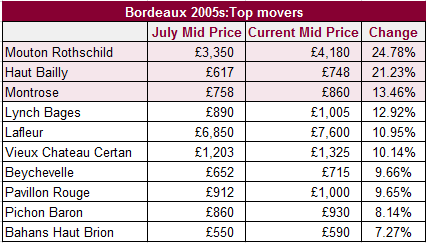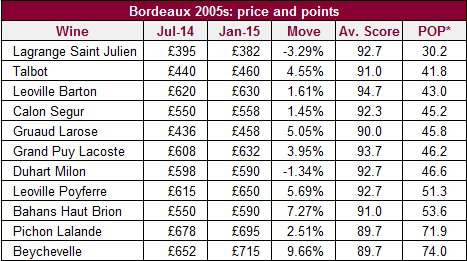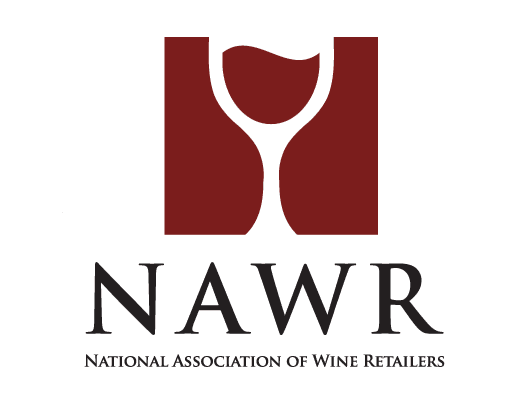Last week we looked at how far the wines of the Bordeaux 500 index had moved since their peak in light of Robert Parker’s recent upgrades: in 2012 Parker conceded that he was “originally worried about the tannin levels in 2005, but the wines are so concentrated I think they will be just fine – they just need a lot of time.”
As the table below shows, it is the three upgraded 2005s that have risen the most since the summer, with Mouton Rothschild leading the charge by jumping 24.8% in just under six months. However, Lynch Bages, Lafleur and other Bordeaux 2005s have also seen gains, suggesting that a ripple effect has taken hold.
The table below looks at wines from this vintage priced at under £60 per bottle. We have taken their average score from three leading Bordeaux critics – Robert Parker, James Suckling and Stephen Tanzer – and compared this to their current mid price to produce a POP (price over points) score, where a lower score represents greater value. Typically, Bordeaux First Growths have POP scores of 200-400.
If upgrades continue to flow, it appears that there may be value to be found in these lower priced wines. Leoville Barton, which has a low POP score of 43, was described by Tanzer as “an outstanding vintage for this wine” yet has largely run flat. The wine with the lowest POP score is Lagrange Saint Julien, which has also failed to bounce since summer. Although only awarded 91 points from Parker, it was awarded 96 points in July 2014 by Suckling who described it as “Stunning now. A fabulous nose of currants, crushed raspberry and blackberry. Full-bodied, with perfectly integrated tannins and a long, caressing finish.” Ten years on from harvest, these wines are coming into sharp focus.
POP
A wine’s POP score is its price-over-points ratio, our loose measure of value. It is calculated by dividing the price of a nine-litre case of wine by a shortened 20-point score. We have calculated this 20-point score by simply subtracting 80 from average ratings of Robert Parker, James Suckling and Stephen Tanzer on the basis that any wine under 80 points is unlikely to attract a secondary market. In theory, the lower the POP score the better value a wine is.
Sources:
www.jamessuckling.com
www.erobertparker.com
www.winespectator.com
www.vinousmedia.com



